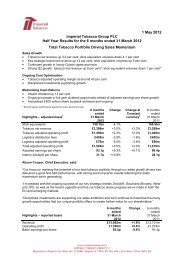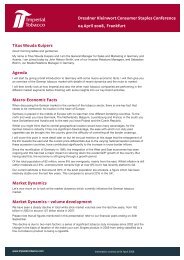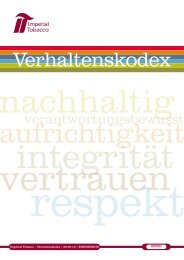Annual report 2004 (English) - PDF 3546K - Imperial Tobacco
Annual report 2004 (English) - PDF 3546K - Imperial Tobacco
Annual report 2004 (English) - PDF 3546K - Imperial Tobacco
You also want an ePaper? Increase the reach of your titles
YUMPU automatically turns print PDFs into web optimized ePapers that Google loves.
72<br />
Energy consumption, water<br />
consumption, waste and CO 2<br />
emissions:<br />
shared environmental performance<br />
indicators<br />
These environmental indicators, prescribed by CORESTA<br />
and culled from the recommendations of the GRI (Global<br />
Reporting Initiative), provide the Group with objective<br />
data for the identifi cation of any corrective measures<br />
required, on a site-by-site basis.<br />
Consolidation procedures have already been completed<br />
at the Cigarette Division and are being fi nalized at the<br />
Cigar Division. For ISO 14001 compliance purposes,<br />
Altadis has initiated action to maximize outcomes<br />
and to raise the awareness of employees at all sites<br />
as well as of subcontractors.<br />
Energy and water consumption:<br />
little room for maneuver<br />
Plant energy consumption is basically dependent<br />
on the production process, which is relatively stable,<br />
and output volume. These factors must be analyzed in<br />
light of changes in the Group’s production organization.<br />
Cigarette Division consolidated data<br />
ENERGY<br />
Total consumption Performance indicator<br />
(gigajoules) (total GJ/output)<br />
2003 1,288,398 12.6<br />
<strong>2004</strong> 1,246,024 13.8<br />
Cigarette Division consolidated data<br />
WATER<br />
Total consumption Performance indicator<br />
(m3 ) (m3 /output)<br />
2003 819,600 8.0<br />
<strong>2004</strong> 697,907 7.8<br />
Total water consumption at the Cigarette Division’s<br />
plants fell by 14.8% in <strong>2004</strong>, thanks mainly to local<br />
measures like the reutilization of chilled water from<br />
the air conditioning system at the Logroño plant.<br />
Energy consumption dropped by 3.3%.<br />
Waste: unrelenting emphasis<br />
on recycling<br />
The primary objective in waste management is to avoid<br />
the use of landfi ll sites. The recovery and maximum<br />
recycling of waste are consequently a priority. Measures<br />
have been taken to raise employees’ and external<br />
providers’ awareness, with a view to sustaining each<br />
site’s internal waste management system. In all,<br />
nearly 60% of waste (paper, plastic, wood, burlap<br />
and tobacco) is recovered and recycled. Hazardous<br />
industrial waste (used oil, batteries, neon lamps, paint,<br />
etc.), representing 2% of total waste, is managed<br />
by authorized, specialized facilities.<br />
Cigarette Division consolidated data<br />
Total waste Performance indicator<br />
(metric tons) (metric tons/output)<br />
2003 16,663 0.163<br />
<strong>2004</strong> 14,977 0.166<br />
In <strong>2004</strong>, the total amount of waste produced by cigarette<br />
plants was cut by 10% relative to 2003. In all, 98% of<br />
this waste is classifi ed as hazardous, in accordance<br />
with prevailing legislation.<br />
Cigarette Division consolidated data<br />
Total recovered waste Performance indicator<br />
(metric tons) (metric tons/output)<br />
2003 8,871 0.088<br />
<strong>2004</strong> 8,465 0.094<br />
Overall, 56.5% of all waste was recovered in <strong>2004</strong>,<br />
either through recycling or incineration with energy<br />
recovery.<br />
The performance indicator concerning waste recycling<br />
or incineration with energy recovery rose by 7% in<br />
<strong>2004</strong>, mainly owing to enhanced selective sorting at<br />
the point of generation. Efforts also focused on the<br />
reduction of packaging waste. The use of fewer and<br />
lighter materials in packets, more effi cient palletization<br />
methods and the replacement of aluminum-coated<br />
papers by less polluting metallic papers have helped<br />
to reduce the waste burden.<br />
In <strong>2004</strong>, the use of lighter packaging cut waste paper<br />
by 160 metric tons. Wood consumption fell by 210 metric<br />
tons as a result of improved palletization. The volume<br />
of plastic waste fell by 18 metric tons.








